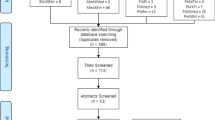Abstract
Recent dierexperimenteel onderzoek heeft aangetoond dat blootstelling aan verslavende stoffen, te weten alcohol, nicotine, heroïne, cocaïne en amfetamine, leidt tot langdurige veranderingen van de prikkeloverdracht in het motivationeel (mesocorticolimbisch) systeem van de hersenen, waardoor er een blijvende overgevoeligheid ontstaat voor de effecten van deze psychoactieve stoffen en voor aan het gebruik geassocieerde omgevingsstimuli (cues).


Similar content being viewed by others
Literatuur
Barlett E., Hallin A., Chapman B. & Angrist B. (1997). Selective sensitization to the psychosis-inducing effects of cocaine: a possible marker for addiction relapse vulnerability? Neuropsychopharmacology 16, 77-82.
Berke J.D. & Hyman S.E. (2000). Addiction, dopamine, and the molecular mechanisms of memory. Neuron 25, 515-532.
De Vries T.J., Schoffelmeer A.N.M., Binnekade R., Mulder A.H. & Vanderschuren L.J.M.J. (1998). Drug-induced reinstatement of heroin- and cocaine-seeking behaviour following long-term extinction is associated with expression of behavioural sensitization. Eur. J. Neurosci. 10, 3565-3571.
De Vries T.J., Schoffelmeer A.N.M., Binnekade R. & Vanderschuren L.J.M.J. (1999). Dopaminergic mechanisms mediating the incentive to seek cocaine and heroin following long-term withdrawal of i.v. drug self-administration. Psychopharmacology 143, 254-260.
Holland P.C. & Gallagher M. (1999) Amygdala circuitry in attentional and representational processes. Trends Cognit. Sci. 3, 65-73.
Kalivas P.W. (1993). Neurotransmitter regulation of dopamine neurons in the ventral tegmental area. Brain Res. Rev. 18, 75-113.
Kalivas P.W., Churchill L. & Klitenick M.A. (1993). The circuitry mediating the translation of motivational stimuli into adaptive motor responses. In: Kalivas, P.W. & Barnes, C.D. (eds) Limbic motor circuits and neuropsychiatry. CRC Press, Boca Raton, p. 237-287.
Kalivas P.W. & Stewart J. (1991). Dopamine transmission in the initiation and expression of drug- and stress-induced sensitization of motor activity. Brain Res. Rev. 16, 223-244.
Kelley A.E. (1999). Neural integrative activities of nucleus accumbens subregions in relation to learning and motivation. Psychobiology 27, 198-213.
Koob G.F. (1992). Drugs of abuse: anatomy, pharmacology and function of reward pathways. Trends Pharmacol. Sci. 13, 177-184.
Markou A., Weiss F., Gold L.H., Caine S.B., Schulteis G. & Koob G.F. (1993). Animal models of drug craving. Psychopharmacology 112, 163-182.
Nestby P., Vanderschuren L.J.M.J., De Vries T.J., Hogenboom F., Wardeh G., Mulder A.H. & Schoffelmeer A.N.M. (1997). Ethanol, like psychostimulants and morphine, causes long-lasting hyperreactivity of dopamine and acetylcholine neurons of rat nucleus accumbens: possible role in behavioural sensitization. Psychopharmacology 133, 69-76.
Nestby P., Vanderschuren L.J.M.J., De Vries T.J., Mulder A.H., Wardeh G., Hogenboom F. & Schoffelmeer A.N.M. (1999). Unrestricted free-choice ethanol self-administration in rats causes long-term neuroadaptations in the nucleus accumbens and caudate putamen. Psychopharmacology 141, 307-314.
Pierce R.C. & Kalivas P.W. (1997). A circuitry model of the expression of behavioral sensitization to amphetamine-like psychostimulants. Brain Res. Rev. 25, 192-216.
Robins T.W. & Everitt B.J. (1996). Neurobehavioural mechanisms of reward and motivation. Curr. Opinion Neurobiol. 6, 228-236.
Robinson T.E. & Berridge K.C. (1993). The neural basis of drug craving: an incentive- sensitization theory of addiction. Brain Res. Rev. 18, 247-291.
Strakowski S.M., Sax K.W., Setters M.J. & Keck P.E. (1996). Enhanced response to repeated d-amphetamine chalenge: evidence for Behavioral sensitization in humans. Biol. Psychiatry 40, 872-880.
Vanderschuren L.J.M.J. & Kalivas P.W. (2000). Alterations in dopaminergic and glutamatergic transmission in the induction and expression of behavioral sensitization: a critical review of preclinical studies. Psychopharmacology 151, 99-120.
Author information
Authors and Affiliations
Rights and permissions
About this article
Cite this article
Schoffelmeer, T. Overgevoeligheid en verslaving. NEPR 4, 134–138 (2000). https://doi.org/10.1007/BF03078982
Issue Date:
DOI: https://doi.org/10.1007/BF03078982




